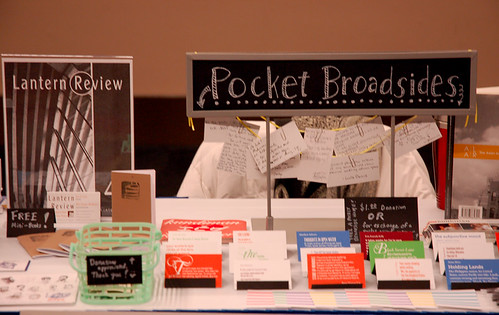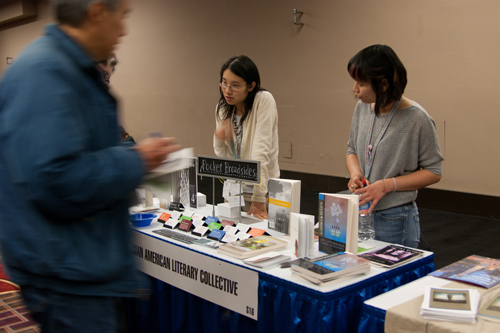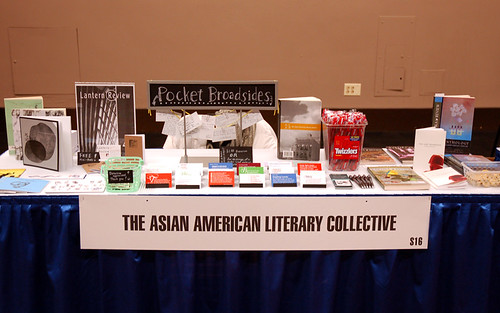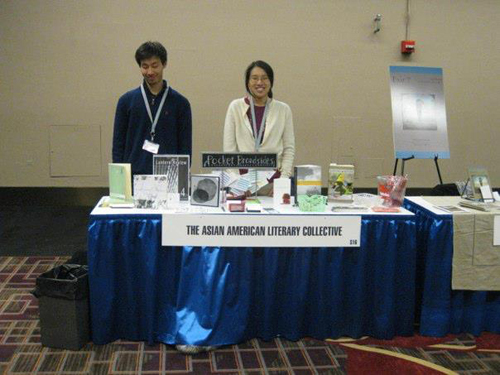
In past years, our experiences at AWP have been a flurry of panels and events. In Denver, we soaked up readings from Kundiman and Cave Canem, From the Fishhouse, and Split this Rock, attended discussions on hybrid and transnational poetry, and had fun introducing LR by word of mouth. In D.C., we spent a little time in the bookfair, hosted a joint off-site reading with Boxcar Poetry Review, were interviewed by APA Compass Radio, and attended a plethora of Asian-American-specific panels that inspired us to probe our own editorial vision more deeply. This year’s conference, however, was different. For the first time, we’d purchased and registered for a spot in the bookfair, and so I spent most of my time down in the exhibition area, manning the table that we were sharing with the lovely folks from Kartika Review. The experience, while exhausting, was wonderfully exhilarating. It was gratifying to get to meet the contributors who stopped by, life-giving to get to share resources with other young Asian American writers who were searching for community. I was encouraged after meeting the handful of teachers who came by in search of resources for particular Asian American students of theirs, and was ecstatic about having the chance to strike up conversations with the many strangers who, in spite of having little familiarity with (or even interest in) Asian American literature, stopped by the table out of sheer curiosity.

In large part, I think we had our joint Pocket Broadsides project to thank for drawing many of those unlikely visitors to our table. (For a brief explanation of the project, see this post). Throughout the weekend, a surprising number of passers-by stopped to examine our colorful display of business-card sized poetry and prose, and ended up staying to chat. As a result, Jennifer Derilo (Kartika‘s nonfiction editor) and I had many fruitful beginnings of conversations about what Asian American literature is, and had the opportunity to talk about and recommend the work of our contributors to people who were relatively unfamiliar with Asian American writing and writers. We were amazed by the ability the Broadsides seemed to have to attract people who might not otherwise have looked at our table. Last year, when Boxcar had been kind enough to allot us some space on their table, Mia and I had noticed that many of the people who’d paused in front of our materials had responded to our attempts at conversation with, “No, thanks, I’m not Asian American,” before beating a rapid retreat. So it was incredibly encouraging this year to see people not only stop to look, but actually talk about, the pieces that we had out on the table. I very much enjoyed getting to hear some of the stories behind why people chose particular Pocket Broadsides (one person selected a micro-prose piece based on the fact that it featured halo-halo—apparently a favorite dessert of hers, while the individual who took home Tamiko Beyer’s poem about teeth said they were going to give it to a friend who was a dentist), and it was equally encouraging to hear the stories behind the pieces that people created for us in exchange, and to see some of them return with friends in tow. By lunchtime on Saturday, all 50 broadsides were gone; Jennifer and I were floored by how rapidly they’d disappeared.

For me, the success of the Pocket Broadside project seemed to underscore the importance of strategic curation in starting conversations about Asian American literature. The people who took broadsides home seemed to be drawn not only to the design and miniature format of the cards, but also to the story behind the project’s creation. In designing the project, we (the LR and KR editors) wanted to come up with an accessible way to showcase the vibrant diversity of work being done by contemporary Asian American writers—one that would allow us to accommodate a large range of contributors, and yet would still make each individual piece feel special in its own right. We wanted to invite people to take home and treasure these pieces of writing, and to understand that the piece they had chosen was part of a living, growing, larger body of work. We wanted to introduce people to both established Asian American writers and to emerging writers with whom they may not have been familiar, and in so doing, to open a door to further discovery of more Asian American literature. We wanted the work, and the appeal of the project, to speak for itself, and in the end, I think it did.

Equally significant to me during this year’s conference, though, was the sense that there was something important about the nature of the table itself—the scope of its collage-like portrait, the range of the work being represented through its evolving display. In the early stages of our planning, both the LR and Kartika editors had felt strongly that we would like to set aside a portion of our table in order represent Asian American literary magazines, presses, and organizations that could not be present, or which did not have a table at AWP. It was important to us (and particularly to Mia and me) that we continue in the same spirit of generosity that had been shown to us in the past by groups like Kundiman, Boxcar, and the Notre Dame Review, and that we be able to represent not just ourselves, but the larger community in which we operate. So we registered under the name “The Asian American Literary Collective” and, in addition to putting our own materials on the table, seeded our display with a copy of the Asian American Literary Review, a few of Corollary Press‘s exquisite hand-bound editions, several of our contributors’ collections and chaps, and neat stacks of Kundiman bookmarks and stickers. As the weekend progressed, and as we met more people, the table became a gathering place of sorts. Contributors stopped by, bringing friends for us to meet, and we added more chapbooks to the table. Kaya Press (which was tabling in another room) gave us some postcards and cookies to share. And the table grew. Although we mowed swiftly through our own materials (not only did we dispense with the Pocket Broadsides quickly, but Kartika sold all of its anthologies, and LR gave away every last business card and mini-book), our table was never empty. Whenever we ran out of something, we simply filled the empty space with more chaps and resources for Asian American writers. It was wonderful to see so many different little presses, publications, and organizations represented in one place. As editors, whose work is inherently curatorial, Jennifer and I felt especially excited to see our publications contextualized in this way. Our evolving table display served as a great reminder of how blessed we are to exist in the midst of of what, during Saturday’s panel on the future of Asian American poetry, moderator Victoria Chang described as a “flowering” of Asian American publishing spaces and literary communities.

I came away from the conference feeling encouraged by the notion that when done strategically and collaboratively, thoughtful curation can be a powerful tool for establishing greater visibility for Asian American writing. Finding ways to make Asian American poetry seen and heard in a significant way is a crucial element of LR‘s mission, and yet it is also one of our greatest challenges. At times, it can feel incredibly daunting to know that we are only one small drop in a vast literary bucket. But this year’s AWP conference served as an excellent reminder of the power of community. Alone, we are just a pinprick on the landscape, but when we intentionally place the work that we do in conversation with that of others who are working towards similar goals, our visibility can grow exponentially. Inspired by our experiences at our table, we’ve already begun to continue this conversation post-conference. Along with the Kartika editors, we’ve begun to discuss and consider how we, and other Asian American literary publications, can work together more closely in the future (beginning with the Pocket Broadsides—which you’ll hear more about in a few weeks!). I can’t wait to see where this dialogue will take us in the weeks and months to come.

I think it is only fitting to end this post with thanks. Mia and I are extremely grateful to all who helped to make our first “official” tabling endeavor possible. Kartika Review‘s partnership and company was both delightful and absolutely invaluable, and we look forward to future collaborations with them. Neil Aitken of Boxcar Poetry Review kindly shared wisdom gleaned from his own past tabling experiences with us, and provided advice about the administrative details of registering for an exhibit space at AWP. Our wonderful columnist Henry helped us staff the table on Saturday, and our generous neighbors, our new friends at Exit 7 and Ghost Ocean Magazine, kindly helped us to keep an eye on our display whenever we needed to leave it temporarily. Andre Yang and Oliver de la Paz took photographs of Jenn, Henry, and me as we worked, and were gracious enough to allow me to share some of them in this post. Finally, I want to acknowledge that although the Pocket Broadsides were a unique joint project by LR and KR, we are neither the first—nor the only—ones to have come up with the idea of printing poetry and prose on business cards. Our friend Tamiko Beyer was putting her poems on the backs of her own business cards long before this year’s AWP, and at the bookfair, Binge Press was also selling their own version of miniature broadsides. A hat tip to both Tamiko and Binge for their beautiful work, and kudos, for the brilliant projects that they continue to pursue.
For additional photographs of our table, plus photo coverage of several of the panels Iris attended in Chicago, see our AWP 2012 Flickr set. Look out for more about our plans to extend the Pocket Broadsides project beyond the AWP bookfair in upcoming weeks.